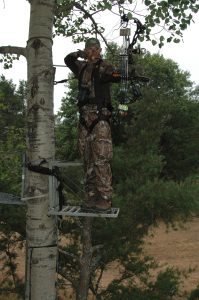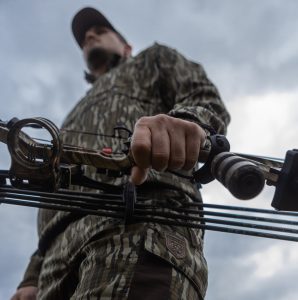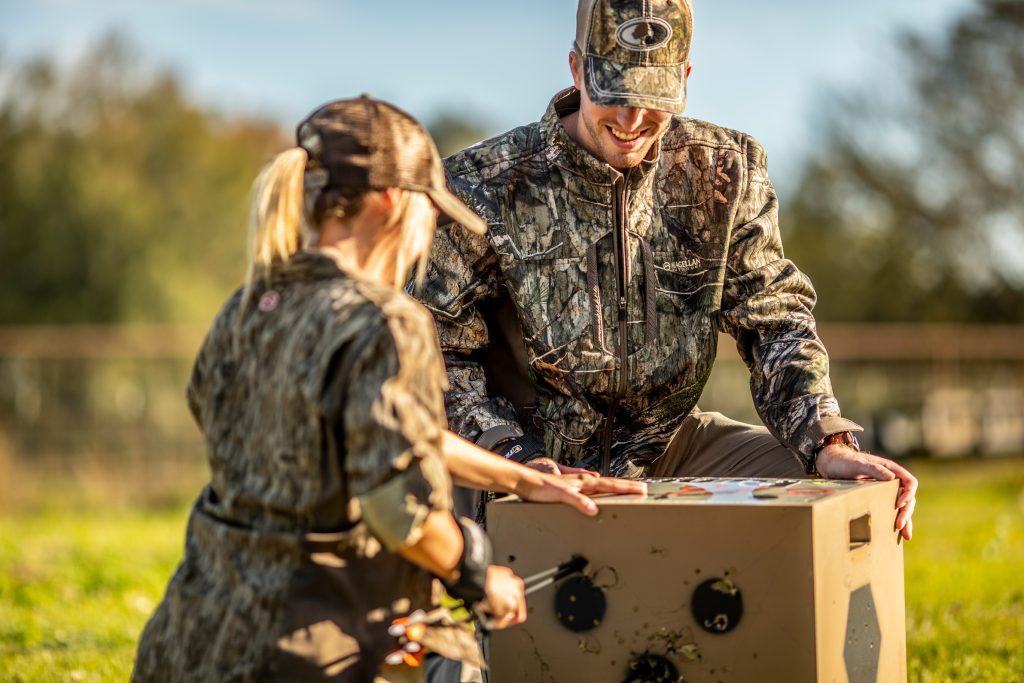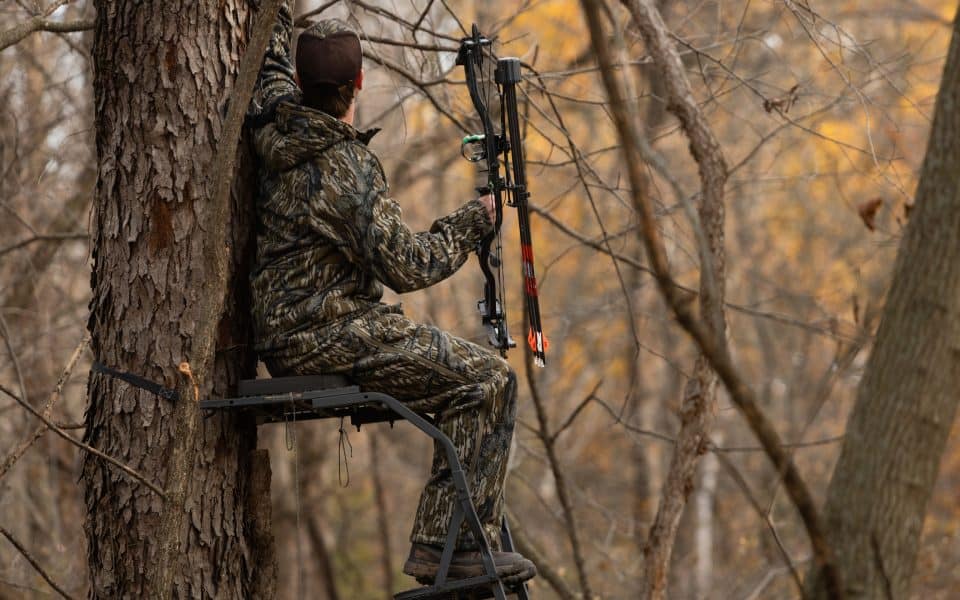Maintaining your bow is much like scent control: one weak link and the whole system could fail. Anything mechanical is susceptible to failure, but taking the proper steps to maintain your equipment can significantly reduce the possibilities. We’ll start with some of the basics, including things you should do on a regular basis, then work our way up.
Maintaining Strings and Cables

Humphrey
Inspect the bowstring, serving and cables, especially at any high wear or contact spots – where they contact cams, cable guards, string dampeners etc. If the string is dried out or shows any slight sign of fraying, apply some string wax. Dab it on the string, then burnish it in by rubbing quickly with your fingers. This friction melts the wax helping it seep into string fibers. Minor fraying of serving can sometimes be fixed with a small dab of nail polish or epoxy. Also check for serving separation. Minor separation can usually be tightened with your fingernails.
If any of these show excessive wear or damage they should be replaced. The cost of a new string and installation is minor compared to the cost of a bow, to say nothing of the medical bills you might end up with should your bow explode. If it’s been more than two years and you shoot regularly, you should probably replace it anyway. Strings stretch, and can throw your bow’s timing and accuracy off.
Because of the string-to-rail contact, crossbow strings experience far more friction and abrasion, and need more attention. Inspect the center serving regularly for wear and separation. The repeated shock of normal use can cause serving to loosen and unravel over time. Slight separation is not unusual but should be fixed. If the string was improperly installed (without the required amount of twists) the serving may separate exposing bow string, which could cause greater wear and breakage.
Between every practice session or hunting trip the center serving and rails should be well lubed for best long-term performance. As a general rule of thumb, lubricate the rail every 75-100 shots with a light oil, or every 150-200 shots when using high-performance oil. Simply add a small drop to each side and rub it in. Don’t over-lubricate as too much oil can saturate the serving and shorten its life. Also avoid petroleum jelly or wax on the serving as they will collect dirt and debris. You can, and should use wax on the string, the same as you would with a compound bow. Just remember: wax on the string, oil on the serving and rail.
Tighten Up Your Bow
Another thing you should do regularly, as in before every time you shoot or hunt, is inspect all fastenings – nuts, bolts and screws – for tightness. From the shock of a bow shot, and even through routine use these loosen up; then bad things can happen. At best, sights and rests move and make noise or you miss a shot. At worst, your bow could come apart or blow up. Snug up everything, but remember: tight is tight; too tight is broken.

Next, check all moving parts for function and noise. Bow makers have gone to great lengths to reduce creaks and squeaks with sealed bearings and rust- or corrosion-resistant materials. Still, some moving parts still need a little lubrication now and then, and a drop of two of oil on your axles and other moving parts will help. Just make sure you use a scent-free oil.
While doing your routine inspections you should also check the limbs, stock and other synthetic parts for cracks or other signs of fatigue. Scratches may be merely cosmetic but deep scratches allow moisture in that could affect the integrity of the material. A little dab of clear nail polish should seal them up. If you notice cracks or de-lamination, seek professional help, like your local pro shop or authorized dealer. They’re more well equipped and experienced in everything from quick fixes to a complete overhaul.
Check Your Accessories
It should go without saying that your bow inspection also includes accessories like sights, rests, quivers, stabilizers and anything else you attach. As with other parts, keep them clean and where necessary, lubricated. Rust and corrosion can affect things like adjustment knobs, ball bearings and the moving parts on drop-away rests. Maybe you use a conventional launcher rest. Check that the Teflon or rubber tips are in good condition. Maybe you used a biscuit-style rest. Are the fibers all in good shape?
Sights are among the most important and delicate components. Check the pins for tightness and breakage. If you use an illuminated sight or scope, check the battery. All too often they get left on, then don’t work when you need them. While you’re at it, jot down the battery size and order a spare or two.
Inspect Triggers & Releases

Humphrey
This is an often overlooked item for both compound and crossbow shooters. Just as you do with your bow, you should regularly inspect the trigger assembly on a crossbow or your trigger release for a compound. In the former case, make sure it’s clean, free of debris and in good working condition. Clean all moving parts with pressurized air or a dry brush, then lubricate according to manufacturer’s specifications as recommendations may vary on the amount and type of lube. Synthetic, non-petroleum based lubes are typically a better choice as they’re less likely to gum up and collect debris or stiffen in extreme cold. It’s somewhat the same for a release aid, and don’t forget to check screws for tightness.
Transporting Your Bow
How you transport your bow from one place to another is part of maintenance as well. In or on a vehicle, a soft case is good but a hard case is better. The latter should be considered mandatory for long trips, and is required for air travel – even then you can never be sure. That brings up another point. After a long trip, especially on a plane, inspect your bow thoroughly before shooting it. Check the strings and cables, all moving parts and fasteners. Then shoot it on the range before you hunt.
In the field, you can simply carry a bow in your hand, or on a sling if you’re using a crossbow. Slings are also a good idea for compounds. In addition to freeing up your hands, they protect strings, cables and cams.
Storing Your Bow
There are some dos and don’ts to both short and long term storage. Some might seem obvious, but we all get lax or complacent now and then. My son once left his bow lying on top of a woodpile while we went to lunch. When we returned an hour later the string was broken and the bow in pieces. We were six hours from home. Fortunately, he was able to borrow a bow to finish the hunt but that may not be the case if you’re in a remote area.
The best way to store a bow is in a hard case. Most folks simply hang it up, which is okay so long as you do it right. Hang it on a secure peg or hook – rubber-coated hooks being a good choice. Hang it on a cam or wheel, never on the string.
Temperature
Another thing you probably don’t give much thought to is temperature. You may be taking your bow out of a warm house or truck into freezing conditions, or out of an air-conditioned vehicle into a hot afternoon on stand. Bow materials, especially metal, expand and contract as temperatures change, and different materials do so at different rates. You might not think it would make that much difference, until you consider the micro adjustments you made when sighting in.
Fortunately, it doesn’t make a huge difference, but it’s still worth at least being aware. If you know it’s going to be cold, you may be better off leaving the bow outside, in a shed, a porch or in a vehicle – in a hard case. The reverse applies when taking it from a cold environment into a hot one, and don’t leave your bow exposed to direct sunlight for extended periods. Dark objects absorb heat and sunlight tends to maintenance degradation.
Tuning Your Bow
This section is where we go beyond routine maintenance and it might be helpful to have another set of eyes. Have someone watch arrow flight while you shoot. Is it straight or does your arrow tend to tail one way or the other? If you practice at close range, you might also look at the entry angle on your target. Paper tuning can also offer clues to inconsistent arrow flight and precision. Adjustment to your nock point or rest are the usual remedy.

Synchronization or lack thereof can sometimes be an issue with twin-cam bows. Your cams should reach the let-off point and stop at the same time. If they don’t, you’re not getting maximum performance and may experience inconsistent arrow placement. String replacement is the first step. If that doesn’t work, take your bow to the shop.








